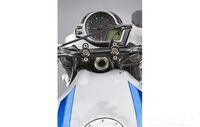Since 1893, when Frederick Jackson Turner declared the closing of the American Frontier, the United States has been urbanizing and suburbanizing faster and faster. This has inevitably produced traffic jams of sometimes epic proportions, prompting my former Car and Driver colleague Brock Yates to conclude decades ago that whenever the roads are perceived as "too open," the ever-watchful members of the Anti-Destination League mobilize and fill them up with slow-moving vehicles, usually in the supposedly fast lanes. American motorcyclists have responded to the ever-increasing congestion with the technique of filtering, or lane-sharing, just as their fellow riders in Europe and Asia have.
It's not just motorcyclists who filter, either. Back in the late 1970s when I was an executive editor at Car and Driver, living and working in downtown Manhattan, I realized that everyone who used the roads or sidewalks there understood what I called "New York Rules." These rules were triggered by any traffic jam at any time. For example, where I lived, at the intersection of East 32nd Street and 3rd Avenue, I could see that every morning and afternoon, the lane-dividing stripes on 3rd Avenue would magically cease to mean anything. What might be four lanes turned into six, or however many cars, trucks, buses or other conveyances that could fit would fill every inch of space available between the sidewalks on the one-way street. It was entirely reasonable, and I never saw a cop bother to try to force people back into the official lanes.
Like any activity involving people, motorcycle filtering can be taken to extremes, as what must be the most-watched YouTube moto-video in recent memory shows. Last time I looked, almost 5 million "views" of the "Black Devil Moscow Ride on R1" made clear the allure of take-it-to-the-limit filtering as practiced by the Black Devil—even as the many comments make clear that the Devil's astonishing blitz-dance through traffic is not condoned by a whole lot of viewers who are riders.
California is a filtering-okay state, so especially when I was working in L.A., I routinely split lanes—though of course I never did as the Black Devil might have, not least because I was usually aboard a testbike and didn't want to contribute too much to the probable annoyance the filtering caused drivers. Andy Goldfine, founder and president of Aerostich, whose invention of the Roadcrafter riding suit changed motorcycling, thinks that filtering ought to be done legally everywhere. So, to help the process along, he developed and brought to market what he calls the "Lane-Sharing Tool," which rotates the bike's license plate down to display a message—his preferred message being an official-looking black-on-yellow "LANE SHARE TEST."
My late colleague and friend, LJK Setright, used to write eloquently of his belief that speed, especially on a motorcycle, is a profoundly civic virtue, not a vice, because, he argued, it preserved for all that one precious thing nobody can buy: time. I suspect that the Black Devil wasn't just trying to save time on his hyper-filtering ride in Moscow, but most who filter are; and Goldfine thinks that showing the motorists stuck while a rider eases past them might smile rather than frown if the last thing they saw as the rider passed were something appropriate spelled out on his Lane-Sharing Tool. As with the question of how filtering is best done, and at what relative speed, the question of what "appropriate" might mean perhaps will always be as open as our frontier no longer is.

/cloudfront-us-east-1.images.arcpublishing.com/octane/ZN44KZLHD5CHVIY3WZYAGTPGSI.jpg)
/cloudfront-us-east-1.images.arcpublishing.com/octane/5A776WXBY5GAPDYFTTUEUZNIJA.jpg)
/cloudfront-us-east-1.images.arcpublishing.com/octane/NCYHFQ2S3BAT7EC7VDN2ONGRTU.jpg)
/cloudfront-us-east-1.images.arcpublishing.com/octane/XQORS527YFFT3MVI326EOEYJUI.jpg)
/cloudfront-us-east-1.images.arcpublishing.com/octane/TVDPP3TGMZHODFXASIFUM2KD34.jpg)
/cloudfront-us-east-1.images.arcpublishing.com/octane/EWDMR3DDTBBQPI7DQVZCLMRFAE.jpg)
/cloudfront-us-east-1.images.arcpublishing.com/octane/4XHHLVOUKFE3PDSWNSV4JJMGOE.jpg)
/cloudfront-us-east-1.images.arcpublishing.com/octane/5RLI3NQKQJA3LKKCQHRXQFTL6Q.jpg)
/cloudfront-us-east-1.images.arcpublishing.com/octane/3QCYJCI2RNBENIRWAKEOEKHFUM.jpg)
/cloudfront-us-east-1.images.arcpublishing.com/octane/XJFFFMRN6VEZ7CDNAGKWVPC3H4.jpg)
/cloudfront-us-east-1.images.arcpublishing.com/octane/RMC3CHWSHFAUJA2WJ2FVG4NBOA.jpg)
/cloudfront-us-east-1.images.arcpublishing.com/octane/WXEZV4WAYBERFKSRE5M7GQBW7A.jpg)
/cloudfront-us-east-1.images.arcpublishing.com/octane/LO3PZVGICFGJZBNUA2ORUSAUSE.jpg)
/cloudfront-us-east-1.images.arcpublishing.com/octane/UFHLTNOXLVARVLZV32M6ZJZV4Y.jpg)
/cloudfront-us-east-1.images.arcpublishing.com/octane/CTSWNU7SNNCC3LWB2KATYZ5AXY.jpg)
/cloudfront-us-east-1.images.arcpublishing.com/octane/72EPJVNA2VGVXJ2BVDFFLN67KQ.jpg)
/cloudfront-us-east-1.images.arcpublishing.com/octane/A7C4GNXEHNHC3LL6RETG6MIPPY.jpg)
/cloudfront-us-east-1.images.arcpublishing.com/octane/Q4KZ7ACKF5BVTE56LMG7RPJCEM.jpg)
/cloudfront-us-east-1.images.arcpublishing.com/octane/RQ2CXG6ATJBUZGUR7NP35C3VBE.jpg)
/cloudfront-us-east-1.images.arcpublishing.com/octane/MWSEWNFALBBJHOQGZTUUPVOQOU.jpg)
/cloudfront-us-east-1.images.arcpublishing.com/octane/LTPXG4ZHCVFNDNILFQ6PN6YUKI.jpg)
/cloudfront-us-east-1.images.arcpublishing.com/octane/EAEWHFARGVGHFH4N4BDOSNBJSU.jpg)
/cloudfront-us-east-1.images.arcpublishing.com/octane/AZ7H35TQSZDKZCVM4S6CHERQEU.jpg)
/cloudfront-us-east-1.images.arcpublishing.com/octane/GYMIU7SMN5CWHP6QLFR6MVKEBU.jpg)